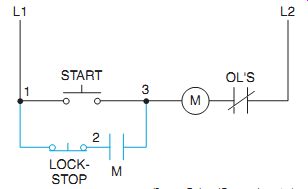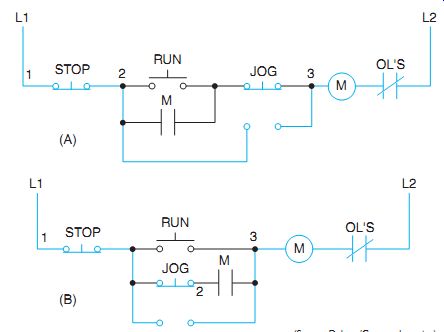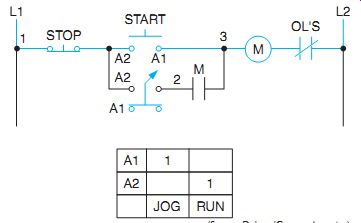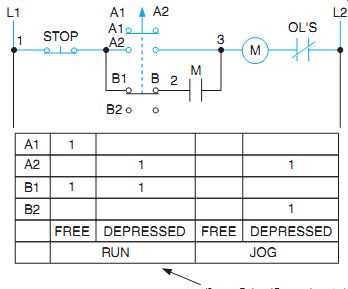AMAZON multi-meters discounts AMAZON oscilloscope discounts
Goals:
• Define the process of jogging control.
• State the purpose of jogging controllers.
• Describe the operation of a jogging control circuit using a control relay.
• Describe the operation of a jogging control using a control relay on a reversing starter.
• Describe the operation of a jogging control using a selector switch.
• Connect jogging controllers and circuits.
• Recommend solutions for troubleshooting jogging controllers.
Jogging, or inching, is defined by NEMA as "the quickly repeated closure of a circuit to start a motor from rest for the purpose of accomplishing small movements of the driven machine." The term jogging is often used when referring to across-the-line starters; the term inching can be used to refer to reduced voltage starters.
Generally, the terms are used interchangeably because they both prevent a holding circuit.
JOGGING CONTROL CIRCUITS
The control circuits covered in this unit are representative of the various methods that are used to obtain jogging.

ill. 1 Lock-stop push button in a jogging circuit.
ill. 1 is a line diagram of a very simple jogging control circuit. The stop button is held open mechanically, ill. 2. With the stop button held open, maintaining contact M cannot hold the coil energized after the start button is closed. The disadvantage of a circuit connected in this manner is the loss of the lock-stop safety feature. This circuit can be mistaken for a conventional three-wire control circuit, locked off for safety reasons, such as to keep a circuit or machine from being energized. A padlock should be installed for safety purpose.
If the lock-stop push button is used for jogging, it should be clearly marked for this purpose.
ill. 3 illustrates other simple schemes for jogging circuits. The normally closed push button contacts on the jog button in ill. 3(B) are connected in series with the holding circuit contact on the magnetic starter.
When the jog button is pressed, the normally open contacts energize the starter magnet. At the same time, the normally closed contacts disconnect the holding circuit. When the button is released, therefore, the starter immediately opens to disconnect the motor from the line. The action is similar in ill. 3(A). A jogging attachment can be used to prevent the reclosing of the normally closed contacts of the jog button.
This device ensures that the starter holding circuit's not reestablished if the jog button is released too rapidly. Jogging can be repeated by reclosing the jog button; it can be continued until the jogging attachment is removed.
CAUTION: If the circuits shown in ill. 3 are used without the jogging attachment mentioned, they are hazardous. A control station using such a circuit, less a jogging attachment, can maintain the circuit when the operator's finger is quickly removed from the button. This could injure production workers, equipment, and machinery. This circuit shouldn't be used by responsible people committed to safety in the electrical industry.

ill. 2 Oil-tight push-button operator with extra long button to accept padlock
attachment (on right) to provide lockout on stop feature. (Eaton Corporation)

ill. 3 Line diagrams of simple jogging control circuits.
JOGGING USING A CONTROL RELAY
When a jogging circuit's used, the starter can be energized only as long as the jog button is depressed. This means the machine operator has instantaneous control of the motor drive.
The addition of a control relay to a jogging circuit provides even greater control of the motor drive. A control relay jogging circuit's shown in ill. 4. When the start button is pressed, the control relay is energized and a holding circuit's formed for the control relay and the starter magnet. The motor will now run. The jog button is connected to form a circuit to the starter magnet. This circuit's independent of the control relay. As a result, the jog button can be pressed to obtain the jogging or inching action.
Other typical jogging circuits using control relays are shown in ill. 5. In ill. 5(A), pressing the start button energizes the control relay. In turn, the relay energizes the starter coil. The normally open starter interlock and relay contact then form a holding circuit around the start button. When the jog button is pressed, the starter coil is energized independently of the relay and a holding circuit does not form. As a result, a jogging action can be obtained.

ill. 4 Jogging is achieved with added use of control relay.

ill. 5 Line diagrams using control relays in typical installations.

ill. 6 Jogging using control relay on a reversing starter.

ill. 7 Jogging using a standard-duty, two-position selector switch.

ill. 8 Jogging using a selector-switch jog with start button.

ill. 9 Jogging using selector push button.
Jogging with a Control Relay on a Reversing Starter
The control circuit shown in ill. 6 permits the motor to be jogged in either the forward or the reverse direction while the motor is at standstill or is rotating in either direction.
Pressing either the start-forward button or the start-reverse button causes the corresponding starter coil to be energized. The coil then closes the circuit to the control relay, which picks up and completes the holding circuit around the start button. While the relay is energized, either the forward or the reverse starter will also remain energized. If either jog button is pressed, the relay is de-energized and the closed starter is released. Continued pressing of either jog button results in a jogging action in the desired direction.
Jogging with a Selector Switch
The use of a selector switch in the control circuit to obtain jogging requires a three-element control station with start and stop controls and a selector switch. A standard-duty, two-position selector switch is shown connected in the circuit in ill. 7. The starter maintaining circuit's disconnected when the selector switch is placed in the jog position. The motor is then inched with the start button. ill. 8 is the same circuit as that shown in ill. 7 with the substitution of a heavy-duty, two-position selector switch.
The use of a selector push button to obtain jogging is shown in ill. 9. In the jog position, the holding circuit's broken, and jogging is accomplished by depressing the push button.
QUIZ:
1. What is the safety feature of a lock-stop push button?
2. In Part (A) of ill. 3, what will happen if both the run and jog push buttons are closed?
3. What will happen if the start and jog push buttons of the circuit shown in ill. 4 are pushed at the same time?
4. In ill. 6,what will happen if both jog push buttons are pushed momentarily?
5. Draw an elementary control diagram of a reversing starter. Use a standard-duty selector switch with forward, reverse, and stop push buttons with three methods of interlocking.